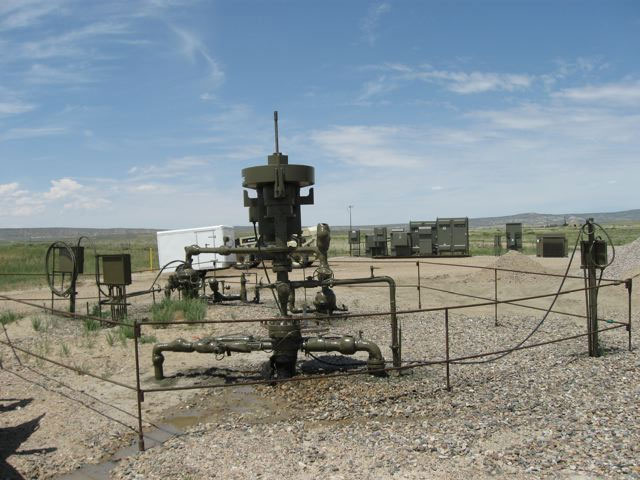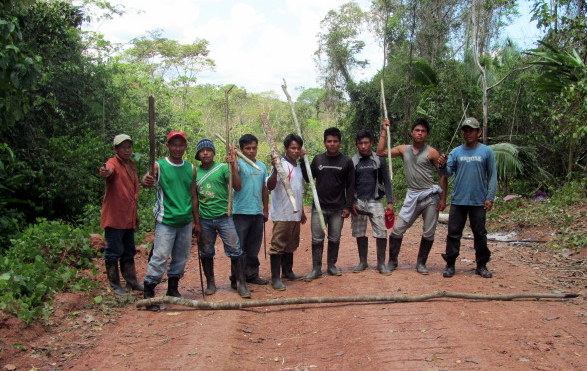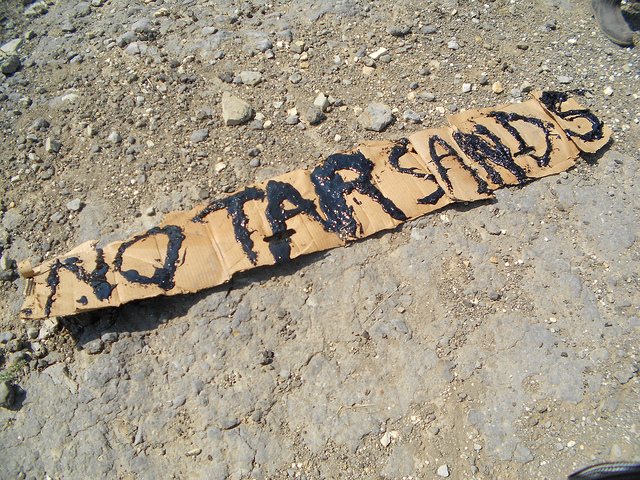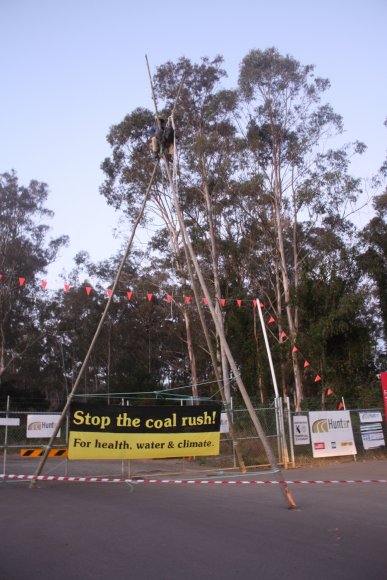
by Deep Green Resistance News Service | Sep 20, 2012 | Toxification
By Abrahm Lustgarten / ProPublica
On a cold, overcast afternoon in January 2003, two tanker trucks backed up to an injection well site in a pasture outside Rosharon, Texas. There, under a steel shed, they began to unload thousands of gallons of wastewater for burial deep beneath the earth.
The waste – the byproduct of oil and gas drilling – was described in regulatory documents as a benign mixture of salt and water. But as the liquid rushed from the trucks, it released a billowing vapor of far more volatile materials, including benzene and other flammable hydrocarbons.
The truck engines, left to idle by their drivers, sucked the fumes from the air, revving into a high-pitched whine. Before anyone could react, one of the trucks backfired, releasing a spark that ignited the invisible cloud.
Fifteen-foot-high flames enveloped the steel shed and tankers. Two workers died, and four were rushed to the hospital with burns over much of their bodies. A third worker died six weeks later.
What happened that day at Rosharon was the result of a significant breakdown in the nation’s efforts to regulate the handling of toxic waste, a ProPublica investigation shows.
The site at Rosharon is what is known as a “Class 2” well. Such wells are subject to looser rules and less scrutiny than others designed for hazardous materials. Had the chemicals the workers were disposing of that day come from a factory or a refinery, it would have been illegal to pour them into that well. But regulatory concessions won by the energy industry over the last three decades made it legal to dump similar substances into the Rosharon site – as long as they came from drilling.
Injection wells have proliferated over the last 60 years, in large part because they are the cheapest, most expedient way to manage hundreds of billions of gallons of industrial waste generated in the U.S. each year. Yet the dangers of injection are well known: In accidents dating back to the 1960s, toxic materials have bubbled up to the surface or escaped, contaminating aquifers that store supplies of drinking water.
There are now more than 150,000 Class 2 wells in 33 states, into which oil and gas drillers have injected at least 10 trillion gallons of fluid. The numbers have increased rapidly in recent years, driven by expanding use of hydraulic fracturing to reach previously inaccessible resources.
ProPublica analyzed records summarizing more than 220,000 well inspections conducted between late 2007 and late 2010, including more than 194,000 for Class 2 wells. We also reviewed federal audits of state oversight programs, interviewed dozens of experts and explored court documents, case files, and the evolution of underground disposal law over the past 30 years.
Our examination shows that, amid growing use of Class 2 wells, fundamental safeguards are sometimes being ignored or circumvented. State and federal regulators often do little to confirm what pollutants go into wells for drilling waste. They rely heavily on an honor system in which companies are supposed to report what they are pumping into the earth, whether their wells are structurally sound, and whether they have violated any rules.
More than 1,000 times in the three-year period examined, operators pumped waste into Class 2 wells at pressure levels they knew could fracture rock and lead to leaks. In at least 140 cases, companies injected waste illegally or without a permit.
In several instances, records show, operators did not meet requirements to identify old or abandoned wells near injection sites until waste flooded back up to the surface, or found ways to cheat on tests meant to make sure wells aren’t leaking.
“The program is basically a paper tiger,” said Mario Salazar, a former senior technical advisor to the Environmental Protection Agency who worked with its injection regulation program for 25 years. While wells that handle hazardous waste from other industries have been held to increasingly tough standards, Salazar said, Class 2 wells remain a gaping hole in the system. “There are not enough people to look at how these wells are drilled … to witness whether what they tell you they will do is in fact what they are doing.”
Thanks in part to legislative measures and rulemaking dating back to the late 1970s, material from oil and gas drilling is defined as nonhazardous, no matter what it contains. Oversight of Class 2 wells is often relegated to overstretched, understaffed state oil and gas agencies, which have to balance encouraging energy production with protecting the environment. In some areas, funding for enforcement has dropped even as drilling activity has surged, leading to more wells and more waste overseen by fewer inspectors.
“Class 2 wells constitute a serious problem,” said John Apps, a leading geoscientist and injection expert who works with the U.S. Department of Energy’s Lawrence Berkeley National Laboratory. “The risk to water? I think it’s high, partially because of the enormous number of these wells and the fact that they are not regulated with the same degree of conscientiousness.”
Read more from ProPublica: http://www.propublica.org/article/trillion-gallon-loophole-lax-rules-for-drillers-that-inject-pollutants

by Deep Green Resistance News Service | Sep 14, 2012 | Colonialism & Conquest, Indigenous Autonomy, Mining & Drilling
By Amazon Watch
Today Talisman Energy (TLM) announced its decision to cease oil exploration activities in the Peruvian Amazon and to exit the country upon completion of ongoing commercial transactions.
“We have fought long and hard against Talisman’s drilling in our territory because of the negative environmental and social impacts we have seen from oil drilling around the world,” said Peas Peas Ayui, President of the National Achuar Federation of Peru (FENAP). “Now that Talisman is leaving we can focus on achieving our own vision for development and leave a healthy territory for future generations.”
Talisman is the fifth oil company to withdraw from controversial Block 64, located in the heart of indigenous Achuar territory in a remote and bio diverse region of the Amazon rainforest. Talisman has been exploring in Peru since 2004 and has come under increased pressure by human rights groups and shareholders for operating without Achuar consent.
“Talisman has had to face up to what the Achuar told them when they first invested in Block 64: The company cannot drill without the consent of the Achuar people,” said Gregor MacLennan, Peru Program Coordinator at Amazon Watch. “Talisman’s exit sends a clear message to the oil industry: Trampling indigenous rights in the rush to exploit marginal oil reserves in the Amazon rainforest is not an option.”
Despite Talisman’s claim of attaining local support from communities and signing good neighbor agreements with 66 communities downriver from their operations, the company never had the consent of the majority of communities living within Block 64. Talisman first invested in Peru one year after leaving Sudan and became sole operator in 2007, shortly after John Manzoni’s appointment as CEO. Manzoni was replaced by ex-TransCanada CEO Hans Kvisle on Monday this week.
“We are the owners and the original people of this land,” said Peas Ayui. “No outside person or company may enter our territory by force, without consultation and without asking us. We have been fighting against oil development on our land for 17 years and we maintain the same vision to protect our territory and resources for future generations. Let this be a clear message to all oil, mining and logging companies: we will never offer up our natural wealth so that they can extract our resources and contaminate our land.”
Block 64 is just one of several new efforts to extract oil from the headwaters of the Amazon in Northern Peru and Southern Ecuador, among the most bio diverse places on earth. Anglo-French company Perenco was recently awarded a production license to operate in Block 67 in Peru despite a legal case against them for drilling in isolated peoples’ territory. ConocoPhilliips has faced mass protests in Iquitos, Peru over plans to drill wells in a protected area in the Nanay river basin east of Block 64. In Ecuador, the government plans to auction new oil blocks on the Peruvian border despite strong indigenous opposition. The Kichwa community of Sarayaku recently won a case in the Inter-American Court of Human Rights against the Ecuadorian government for signing an oil contract without their consent or consultation.
From Amazon Watch: http://amazonwatch.org/news/2012/0913-talisman-energy-withdraws-from-peruvian-amazon

by Deep Green Resistance News Service | Sep 10, 2012 | Indigenous Autonomy, Mining & Drilling, Obstruction & Occupation, Toxification
By Ronald Suarez, Network of Peruvian Indigenous Communicators, Ucayali
Over 400 villagers in the Native Community of Canan de Cachiaco in the Ucayali region of the Peruvian Amazon have taken control of nine oil wells, belonging to oil company, Maple Gas, in oil lot 31B.
Community members took over the oil wells on September 2nd, and continue to hold them as a result of 37 years of oil contamination in their territory by the company.
The community leader, Basilio Rodriguez Venancio, said the action was made necessary because the company did not consider the environmental impact assessment carried out by an independent consultant.
The community is demanding that the company pay them compensation for the use of their lands and for the environmental damage they have suffered for 37 years. Such damage includes the contamination of their rivers, their only source of drinking water, and the contamination of their soils due to the company’s use of chemicals and heavy minerals, which the population says has significantly affected the productivity of their land.
Several community members testified that they have become sick due to the company’s negligence and contamination of their drinking water. There have been several instances in the past years of cancer and ¨unknown deaths¨ that the community attributes to company abuses.
The community awaits the arrival of state representatives from the Ministry of Energy and Mines and Ministry of Environment, scheduled for Thursday, September 13th, to resolve this conflict.
Meanwhile the villagers are still stationed in the camp until authorities settle their claims.
From Alianza Arkana

by Deep Green Resistance News Service | Sep 8, 2012 | Lobbying, Mining & Drilling, Movement Building & Support
By Melanie Jae Martin / Waging Nonviolence
Last week, a new front opened in the struggle against tar sands mining in the U.S. If you didn’t know that tar sands mining is in the works on this side of the border in the first place, you’re not alone. Most people don’t realize that tar sands extraction, which has caused tremendous pollution and environmental degradation in Canada, has crossed the border to U.S. soil, where it has taken root in Utah.
Activists on both sides of the border have been working fervently to halt the spread of tar sands in Canada and the piping of tar sands oil from Alberta to Texas. Beginning with Tar Sands Action’s mass arrests outside the White House in August 2011, followed by the Indigenous Environmental Network’s protests at the climate talks in Durban that December, activists have made Canadian tar sands mining and the Keystone XL pipeline to the Gulf of Mexico a high-profile issue this past year.
Now, direct action campaigns like the Tar Sands Blockade in Texas are continuing the effort to stop construction of the southern leg of the pipeline by disrupting business as usual for the oil industry. The threat of tar sands mining in the U.S., however, complicates the struggle. It forces geographically divergent groups to either divide their efforts or find ways to unite across vast distances. That’s why groups like Utah Tar Sands Resistance and Before It Starts are forming a strategy that can join, as well as compliment, the tornado of opposition that has formed against the tar sands industry.
Before It Starts — co-founded by Ashley Anderson, who began Peaceful Uprising with Tim DeChristopher in 2009 — is focusing primarily on national outreach, while Utah Tar Sands Resistance is focusing on forging local and regional coalitions. In both groups, activists who have experience in nonviolent direct action are prepared to ramp up efforts when the time is right. Thus far, however, the struggle has mainly been waged in the courtroom.
The environmental group Living Rivers initiated a legal challenge in 2010 to halt the progress of what’s set to become the first commercial tar sands mine in the U.S. — a forested area in Eastern Utah called PR Spring, which the state has leased a portion of to the Canadian mining company U.S. Oil Sands. Living Rivers has contested the company’s permit to dump wastewater at the mine, but last week, the judge — an employee of the Utah Department of Environmental Quality — sided with U.S. Oil Sands, granting it the right to pour toxic wastewater into the remote wilderness of eastern Utah.
The case hinged on whether or not PR Spring contains groundwater. In the hearing back in May, U.S. Oil Sands argued that the land holds no groundwater, which means that polluting the land wouldn’t contaminate water systems. But according to engineering geologist Elliott Lips, who spoke as a witness for Living Rivers, the land holds numerous seeps and springs, which the toxic tailings would pollute before either continuing to flow into rivers or percolating downward into the Mesa Verde aquifer. Ultimately, the judge was satisfied knowing that the company had conducted its own tests and would have reported water if it had found any.
Raphael Cordray, co-founder of the Utah Tar Sands Resistance, explains that tar sands mining would be incredibly destructive in a number of ways, such as polluting water, lowering river levels and destroying diverse ecosystems. “There’s so much wild land in our state, and that’s something I’m proud of,” she said. “That’s our legacy. And it’s a treasure for the whole world. Some of these places they’re trying to mine are so unique that if more people realized they existed, they’d certainly be considered national parks.”
To catalyze mass resistance, the group plans to lead trips to the site. “Helping people experience the majesty of this land firsthand will show people how much is at stake, and move them to take a stronger stand,” said Utah Tar Sands Resistance co-founder Lionel Trepanier.
Together with activists from Peaceful Uprising and Living Rivers, Utah Tar Sands Resistance visited the PR Spring site two weeks ago, and members returned home ready to ramp up efforts to halt the mining. As a member of both groups, I went along on the trip, because I wanted to see firsthand what the land looked like and whether the mining company’s claims about the absence of groundwater were accurate.
As it turns out, they couldn’t be more false. Water has etched its presence into this land, leaving creek beds that may run low at times but never go away. And clearly, the area holds plenty of water to support the large herds of deer and elk, as well as the aspen, Douglas firs and pinyon pines that make up the dense forest covering much of the land.
This vibrant green scenery was juxtaposed by the two-acre strip mine just feet away from the forest’s edge. The difference between life and death could not have been more stark. Looking into the face of such destruction, I realized it’s no longer about saving the ecosystem, or saving our water — it’s about saving life on Earth. But that kind of effort isn’t possible without a broad movement behind it.
According to Lionel Trepanier, the groups working on this issue are looking to Texas’ Tar Sands Blockade as a model for building a broad coalition that includes “diverse groups of people like ranchers, hunters, the Indigenous community and climate justice activists.”
“I think we so often assume that someone won’t agree with us just because they seem different from us, when they could be our biggest ally,” said Cordray. “We’re committed to breaking down those barriers formed by fear of reaching out, and approaching people as human beings who need clean water and a healthy environment just as much as we do.”
Read more from Waging Nonviolence: http://wagingnonviolence.org/2012/09/opposition-mounts-as-first-tar-sands-mine-in-us-gets-a-green-light/

by Deep Green Resistance News Service | Sep 5, 2012 | Mining & Drilling, Obstruction & Occupation
By Rising Tide Australia
Activists entered the Hunter 8 Alliance compound at Rutherford before dawn today, erecting a wooden tripod to block access to the site, which is part of a Federally funded project to increase coal haulage capacity in the Hunter Valley. Activist Ned Haughton scaled the 10 metre high structure, where he remained for the next five and a half hours. Haughton has now been arrested, and will be charged with obstruction.
Steve Phillips, spokesperson for protest organisers Rising Tide, said: “This railway construction project is designed purely for the benefit of coal corporations, yet it is being paid for with taxpayers money.”
“Why are taxpayers dollars being handed over to rich mining corporations, in order to prop up a polluting industry that is destroying human health and the environment?”
“There is a coal rush under way in NSW, and public health, waterways, ecosystems, and the global climate are under assault. Massive coal mine projects, coal haulage projects, and coal port projects are in the pipeline. If all these projects go ahead, the consequences will be devastating.”
Today’s protest follows two consecutive days of community direct action against the Boggabri mine in the Gunnedah Basin – the coal industry’s “new frontier”. A major expansion of the Boggabri coal mine was approved by the NSW Government in July despite huge ecological impacts and overwhelming community opposition.
“We call on State and Federal Governments to abandon their infatuation with mining companies, and their addiction to fossil fuels. It’s time to take a stand and stop this coal rush before it’s too late.”
Key facts.
- The Maitland to Minimbah Third Track project is being constructed by Hunter 8 Alliance, which is a consortium of engineering company GHD, construction company John Holland, and the Federally owned Australian Rail Track Corporation.
- The objective of the project is to lift coal haulage capacity on the Hunter rail corridor to 200 million tonnes per annum. It includes construction of 23km of new rail track, and reconditioning of 9km of existing track.
- The Federal Government granted $114 million, through the ARTC, to the project.
From Rising Tide Australia





